


Amazonian Country Located at he heart of the Equatorial Line

©1996 el-ecuador.com - All rights reserved. - This Web site was created and maintained by: Fernando Silva
This site was last updated on: March 16, 2025



Welcome
Republic of Ecuador
The Republic of Ecuador is located between Peru to the south and Colombia to the north, it may be the smallest South American country on the map, but it is full of the most amazing and diverse landscapes. From north to south and throughout the country we find places full of history, the most amazing colonial architecture, colonial historical landmarks, national parks with impressive and beautiful volcanic lakes, inactive and currently active volcanoes, Amazonian National Parks with modern facilities to accommodate their guests. visitors, and some of the best coastal towns and beaches.Geographical coordinates2 00 S, 77 30 W
The volcanoes of Ecuador belong to the Northern
Volcanic Zone of the Andes, which is the result of
the subduction of the Nazca Pacific oceanic plate
under the South American continental plate. One of
the things that Ecuador is most famous for is its
volcanoes.
Ecuador is located in the northern part of South America, shares its border to the north with Colombia, to the south-southeast with Peru and to
the west with the Pacific Ocean.
The Equatorial Line or Parallel 0 ° cuts the country in the northern part; divides the Earth into two hemispheres, North and South. A unique
experience if you stand on the Equator with one leg in each hemisphere.
Ecuador's climate, although located in the heart of the tropics, ranges from glacial to tropical.
In the region of the Sierra (Andes) the temperatures oscillate between subtropical, warm, cold
and glacial.
In the Coastal and Amazon regions, you will find temperatures ranging from dry tropical, warm
tropical, and high humidity tropical. These factors determined the specific vegetation and
fauna of the regions. Temperatures are unpredictable and are marked more by altitude than
by calendar.
Quito is the capital of Ecuador, an architectural treasure represented in its temples and
monasteries that preserve creativity, intellect and art, an indelible sign of its culture.
This is where in the past a group of brave adventurers set out for "The Country of Cinnamon".
A heroic event that ended with the discovery of the great Amazon River. The old town of Quito
is so beautiful that it was declared a World Heritage Site by UNESCO in 1978.
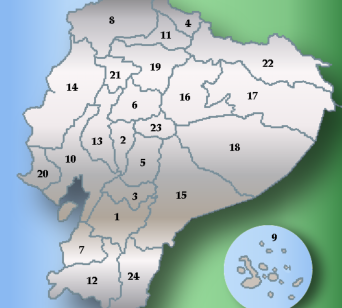


Provinces
1. Azuay
2. Bolivar
3. Cañar
4. Carchi
5. Chimborazo
6. Cotopaxi
7. El Oro
8. Esmeraldas
9. Galápagos
10. Guayas
11. Imbabura
12. Loja
13. Los Ríos
14. Manabi
15. Morona-Santiago
16. Napo
17. Orellana
18. Pastaza
19. Pichincha
20. Santa Elena
21. Santo Domingo
22. Sucumbíos
23. Tungurahua
24. Zamora-Chinchipe
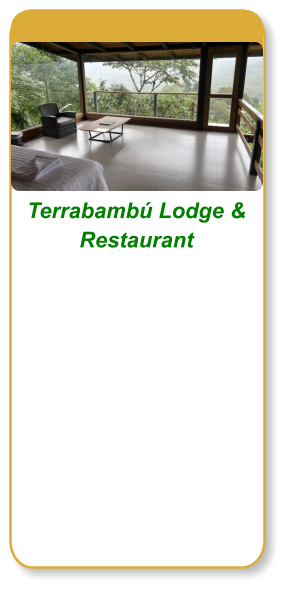
Terrabambú Lodge
The visual experience
you'll have at
Terrabambú and its
surroundings will be
superlative.
Warm ambiances and
comforting spaces
await you.
Contact Us

NUNA TREK
Adventures That
Transform Lives!
We are a tourism company
with 8 years of experience
offering unforgettable
adventures throughout
Ecuador.
From the majestic Andes
to the Amazon Rainforest
and the Pacific Coast, we
have a team of experts
who guarantee safety and
fun on every tour.
Contact us
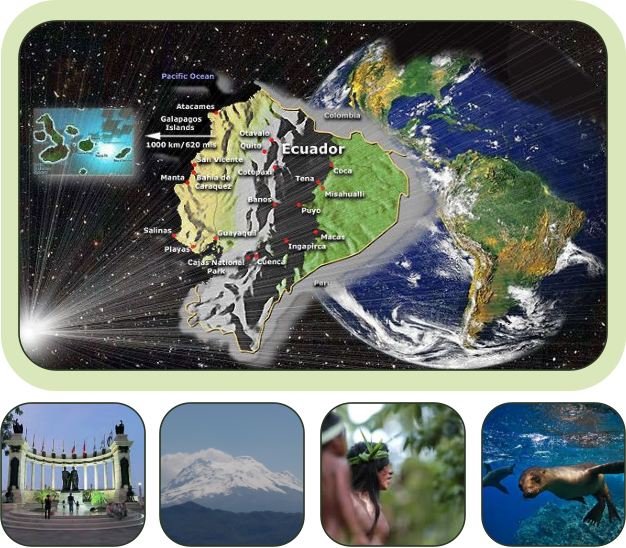
Ecuador is the example of America. This was demonstrated with the first fight for freedom on August 10, 1809. This event was the beginning of a
consolidation of ideas for freedom that was finally achieved on May 24, 1822, with the independence of the Spanish conquerors.
Ecuador is divided by two distinct Andean mountain ranges, the "Cordillera Occidental" in the west and the "Cordillera Central" in the east. Home
to spectacular and snow-capped volcanoes such as: Chimborazo, Cotopaxi (the highest active volcano in the world), Tungurahua, Cayambe,
Antisana, Altar, Iliniza, Sangay, Cotacachi and others that stand as great guardians of the nations. These peaks include some of the highest in
South America, totaling about ten peaks over 5,000 meters or 16,600 feet.
The subsoil of Ecuador is rich in minerals, some of them in great abundance: oil, gold, silver, zinc, lead, nickel, sulfur, quartz and marble among
others. The Ecuadorian economy is governed by two large groups, oil and agricultural products, a third and smaller group is the tourism industry.
High-quality oil is found in the Amazon Region and is transported to Esmeraldas on the Pacific Coast through the Andean Region through
pipelines. Here the oil is partly processed for domestic consumption and the rest is exported to various countries around the world. Oil
represents approximately 30% of Ecuador's total exports.
The Coastal Region is home to extensive plantations of tropical products. Ecuador is the world's largest exporter of bananas, other products
include: coffee, cocoa, hearts of palm, mangoes, melons and citrus fruits among others. Another important part of the Ecuadorian economy in
this region is the shrimp industry. Ecuador has become the second largest exporter of pool-grown shrimp in the world, both in its entirety and in
processed products.
Tourism in Ecuador is a growing industry, dominated by ecological wealth and cultural
heritage Ecuador has several points of attractions, one of the most important sites is
the Galapagos Islands, a living wonder that was formed through thousands of years of
volcanic activity in the sea. For the mountaineer, the Sierra Alta contains some of the
most spectacular landscapes in South America and for explorers, the jungle of the
East is loaded with biological diversity.
One of the last industries born in Ecuador are flowers. Roses and carnations began to
be exported in 1983, since then the plantations have expanded to many different
types of flowers that are being exported to countries such as: United States, Spain,
Holland and Russia among others. Galapagos, the Coast and the Sierra share a rainy
period from January to May; The difference is that the Coast and Galapagos have an
average temperature of 80 ° F and the mountains of 60 ° F. The temperature of Quito
remains constant and moderate throughout the year, with minimum temperatures of
40 ° F and maximum temperatures of 70 ° F. The Amazon is hot and humid all year
round, but the rainiest months are from April to September.
Although it is a small country, Ecuador contains within its borders a wide variety of
landscapes, fauna and culture. Like most of South America, Ecuador has the mixture
of three cultures, the Spanish, the Inca and the local indigenous. Spanish is the official
language of the country, but a large majority of the indigenous community speaks the
indigenous language. Quechua was the language imposed by the Incas on the local
western tribes. Jivaroan (Jivaro) is the language spoken by the Indians in the eastern part of the country. The Jivaro tribes are well known
throughout the world as the famous and feared "Shrink-Heads".
Ecuador's currency is the United States dollar, adopted nationally in September 2000 to replace the initial currency "Sucre". This is truly a
country where a little money goes a long way, many Americans have found their little paradise away from home to retire. Cuenca, the capital of
the Azuay province, is one of Ecuador's best secret retreat spots, located in the highlands at about 8,202 feet above sea level with temperatures
around 51 ° F (11 ° C) and 75% humidity.
The Republic of Ecuador has a Democratic Government elected every 4 years, divided into 24 Provinces that extend from the Pacific Ocean to
the heart of the Andes Mountains and cross the Amazon rainforest. Ecuador is geographically divided into four regions:
1.- Coast: Coastal Zone
2.- Sierra: The Andean and inter-Andean plateau
3.- Amazon: The Amazon Rainforest
4.- Insular: Galapagos Islands
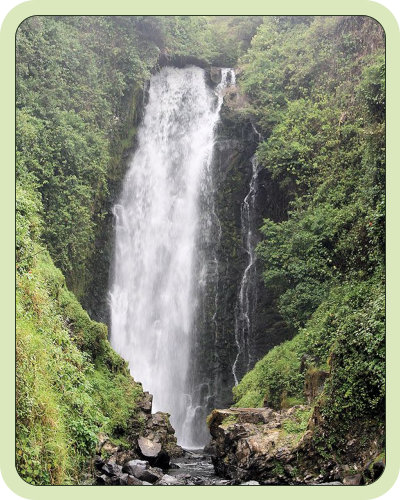
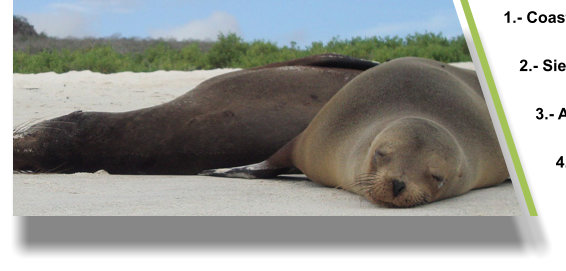


Sacha Ñampi Ecolodge
Yasuni
The Best Experience
Thanks to the strategic
location of our operations
center, we visit the Yasuní
park, the Cuyabeno
reserve and many other
sites of great ecotourism
interest.
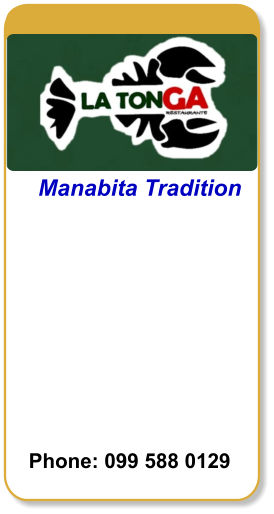
La Tonga Restaurant
The best manabita
food in Quito!
We are in Quito and
Nayon, we offer the best
dishes. All our
preparations are made
with dedication and
experience.






















